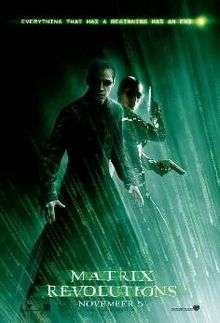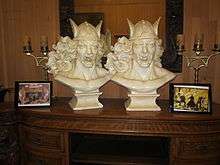The Matrix Revolutions
| The Matrix Revolutions | |
|---|---|
 Theatrical release poster | |
| Directed by | The Wachowski Brothers |
| Produced by | Joel Silver |
| Written by | The Wachowski Brothers |
| Starring | |
| Music by | Don Davis |
| Cinematography | Bill Pope |
| Edited by | Zach Staenberg |
Production companies |
|
| Distributed by |
|
Release dates |
|
Running time | 129 minutes[2] |
| Country | |
| Language | English |
| Budget | $110 million[4] |
| Box office | $427.3 million[5] |
The Matrix Revolutions is a 2003 American–Australian science fiction action film written and directed by The Wachowski Brothers. It was the third installment of the Matrix trilogy, released six months following The Matrix Reloaded. The film was released simultaneously in 60 countries on November 5, 2003. While it is the final film in the series, the Matrix storyline is continued in The Matrix Online. It was the second live-action film to be released in both regular and IMAX theaters at the same time.
Plot
Neo and Bane lie unconscious in the medical bay of the ship Hammer. Meanwhile, Neo finds his digital self trapped in a virtual subway station—named, "Mobil Ave.", "mobil", being an anagram for "limbo"—a transition zone between the Matrix and the Machine City. In that subway station, he meets a "family" of programs, including a girl named Sati, whose father tells Neo the subway is controlled by the Trainman, an exiled program loyal to the Merovingian. When Neo tries to board a train with the family, the Trainman refuses and overpowers him.
Seraph contacts Morpheus and Trinity on behalf of the Oracle, who informs them of Neo's confinement. Seraph, Morpheus and Trinity enter Club Hel, where they confront the Merovingian and force him to release Neo. Troubled by visions of the Machine City, Neo visits the Oracle, who reveals that Smith intends to destroy both the Matrix and the real world. She states that "everything that has a beginning has an end", and that the war will conclude. After Neo leaves, a large group of Smiths assimilates Sati, Seraph and the unresisting Oracle, gaining her powers of precognition.
In the real world, the crew of the Nebuchadnezzar and the Hammer find and reactivate Niobe's ship, the Logos. They interrogate Bane, who says that he has no recollection of the earlier massacre. As the captains plan their defense of Zion, Neo requests a ship to travel to the Machine City. Motivated by her encounter with the Oracle, Niobe offers him the Logos. Neo departs, accompanied by Trinity. Bane, who has stowed away on the Logos, takes Trinity hostage. Neo realizes that Bane has been assimilated by Smith. Bane cauterizes Neo's eyes with a power cable, blinding him; however, Neo discovers an ability to perceive the world as golden light. Neo kills Bane, and Trinity pilots them to the Machine City.
Niobe and Morpheus set out for Zion with the Hammer to aid the human defenses against the Sentinels. In Zion, the fatally wounded Captain Mifune instructs Kid to open the gate for the Hammer. When it arrives, it discharges its EMP, disabling the Sentinels but also the remaining defenses. The humans are forced to retreat and wait for the next attack, thinking that it will be their last stand. Near the Machine City, Neo and Trinity are greeted by thousands of missiles which Neo attempts to destroy, but is overwhelmed by their numbers. The Logos is attacked by the Sentinels forcing them to fly above the missiles for a few seconds. They breach the cloud layer and see Earth's real sky, to which Trinity whispers the word "Beautiful". Upon descent, they lose control causing them to crash the Logos into the Machine City. The crash kills Trinity. Neo enters the Machine City and encounters "Deus Ex Machina", the machine leader. Neo, warning that Smith plans to conquer both the Matrix and the real world, offers to stop Smith in exchange for peace with Zion. The machine leader agrees, and the Sentinels stop attacking Zion.
The Machines provide a connection for Neo to enter the Matrix. Inside, Neo finds that Smith has assimilated all its inhabitants. The Smith with the Oracle's powers steps forth, saying that he has foreseen his victory against Neo. After a protracted battle, Neo—finding himself unable to defeat Smith—allows himself to be assimilated. The machine leader sends a surge of energy into Neo's body in the real world. Because Neo is connected to the Source, the energy surge causes the Neo-Smith clone and all other Smith clones in the Matrix to be destroyed, though Neo dies in the process. The Sentinels withdraw from Zion, Morpheus and Niobe embrace, and Neo's body is carried away by the machines. The Matrix reboots, and the Architect encounters the Oracle in a park. They agree that the peace will last "as long as it can", and that all humans will be offered the opportunity to leave the Matrix. The Oracle tells Sati that she thinks they will see Neo again. Seraph asks the Oracle if she knew this would happen; she replies that she did not know, but she believed.
Cast
- Keanu Reeves as Neo
- Laurence Fishburne as Morpheus
- Carrie-Anne Moss as Trinity
- Hugo Weaving as Smith
- Jada Pinkett Smith as Niobe
- Mary Alice as the Oracle
- Harry J. Lennix as Commander Lock
- Harold Perrineau as Link
- Lambert Wilson as the Merovingian
- Monica Bellucci as Persephone
- Nona Gaye as Zee
- Anthony Zerbe as Councillor Hamann
- Nathaniel Lees as Captain Mifune
- Collin Chou as Seraph
- Ian Bliss as Bane
- Helmut Bakaitis as the Architect
- Tanveer K. Atwal as Sati
- Bruce Spence as the Trainman
- Gina Torres as Cas
- Clayton Watson as Kid
- Cornel West as Councillor West
- Bernard White as Ramachandra
- David Roberts as Captain Roland
- Anthony Wong as Ghost
- Tharini Mudaliar as Kamala
- Maurice J. Morgan as a tower soldier
Actress Gloria Foster, who played the Oracle in the first and second films, died before the completion of her filming for the third.[6] She was replaced by actress Mary Alice. Her changed appearance is addressed in the film's plot.[7]
Production

Filming occurred concurrently with its predecessor, The Matrix Reloaded, and live-action sequences for the video game Enter the Matrix. This took place primarily at Fox Studios in Sydney, Australia.[8][9]
Sound design
Sound editing on The Matrix trilogy was completed by Danetracks in West Hollywood, California.
Soundtrack
In contrast to its predecessors, very few "source" tracks are used in the film. Aside from Don Davis' score, again collaborating with Juno Reactor, only one external track (by Pale 3) is used. Although Davis rarely focuses on strong melodies, familiar leitmotifs from earlier in the series reappear. For example, Neo and Trinity's love theme—which briefly surfaces in the two preceding films—is finally fully expanded into "Trinity Definitely"; the theme from the Zion docks in Reloaded returns as "Men in Metal", and the energetic drumming from the Reloaded tea house fight between Neo and Seraph opens "Tetsujin", as Seraph, Trinity and Morpheus fight off Club Hel's three doormen. The climactic battle theme, named "Neodämmerung" (in reference to Wagner's Götterdämmerung), features a choir singing extracts (shlokas) from the Upanishads. The chorus can be roughly translated from Sanskrit as follows: "lead us from untruth to truth, lead us from darkness to light, lead us from death to immortality, peace peace peace". The extracts were brought to Davis by the Wachowski Brothers when he informed them that it would be wasteful for such a large choir to be singing simple "ooh"s and "aah"s (according to the DVD commentary, Davis felt that the dramatic impact of the piece would be lost if the choir was to sing 'This is the one, see what he can do' in plain English). These extracts return in the film's denouement, and in Navras, the track that plays over the closing credits (which may be considered a loose remix of "Neodämmerung").
Reception
Box office
The film's budget is an estimated US$110 million.[4] It grossed over $139 million in North America and approximately $427 million worldwide,[5] roughly half of The Matrix Reloaded box-office total. In its first five days of release, it grossed $83.8 million,[10] but dropped 66% during the second week.[10]
Home media
The Matrix Revolutions was released on DVD and VHS on April 6, 2004. The film grossed $116 million in DVD sales.
Critical reception
The film received a score of 36% on Rotten Tomatoes.[11] The film's average critic score on Metacritic is 47/100.[12]
Some critics criticized the film for being anticlimactic.[13][14] Additionally, some critics regard the film as less philosophically ambiguous than its predecessor, The Matrix Reloaded.[15][16] Critics had difficulty finding closure pertaining to events from The Matrix Reloaded, and were generally dissatisfied.[17][18]
Conversely, Roger Ebert of the Chicago Sun-Times gave the film three stars out of four, despite offering criticisms of his own, on the grounds that it at least provided closure to the story well enough so that fans following the series would prefer seeing it as to not.[19]
See also
References
- ↑ "Film Distribution". Village Roadshow Limited. Retrieved February 11, 2014.
- ↑ "The Matrix Revolutions". British Board of Film Classification. Retrieved September 15, 2013.
- 1 2 "The Matrix Revolutions (2003)". British Film Institute. Retrieved July 22, 2015.
- 1 2 Allmovie. 2010b. The Matrix Revolutions. [Online] Rovi Corporation (Updated 2010) Available at: http://www.allmovie.com/movie/the-matrix-revolutions-v282917 Accessed 19 February 2010. Archived at http://www.webcitation.org/5nfGxGihq?url=http%3A%2F%2Fwww.allmovie.com%2Fwork%2Fthe-matrix-revolutions-282917.
- 1 2 "The Matrix Revolutions (2003)". Box Office Mojo. Retrieved February 13, 2015.
- ↑ McKinley, Jesse (October 5, 2001). "Gloria Foster, Stage Actress, Is Dead at 64". The New York Times. Retrieved January 26, 2015.
- ↑ Hoberman, J. (November 4, 2003). "Holy Trinity". The Village Voice. Retrieved January 26, 2015.
- ↑ Sams, Christine (May 11, 2003). "Sydney sci-fi fans rush to re-enter the Matrix". The Sun-Herald. Retrieved January 26, 2015.
- ↑ Buchanan, Levi (February 12, 2003). "'Enter the Matrix' aims to open a new game era". Chicago Tribune. Retrieved January 26, 2015.
- 1 2 http://www.boxofficemojo.com/movies/?page=weekend&id=matrixrevolutions.htm
- ↑ "The Matrix Revolutions Movie Reviews, Pictures – Rotten Tomatoes". Rottentomatoes.com. Retrieved 2012-07-11.
- ↑ "Matrix Revolutions, The (2003): Reviews". Metacritic.com. 2003-11-05. Retrieved 2012-07-11.
- ↑ "Time to pull the plug on The Matrix. – By David Edelstein – Slate Magazine". Web.archive.org. 2010-07-27. Archived from the original on July 11, 2010. Retrieved 2012-07-11.
- ↑ Clark, Mike (2003-11-04). "– 'The Matrix Revolutions': This big finish isn't The One". Usatoday.com. Retrieved 2012-07-11.
- ↑ Scott Foundas (2003-11-06). "LA Weekly – Film+TV – The More the Murkier – Scott Foundas – The Essential Online Resource for Los Angeles". Laweekly.com. Retrieved 2012-07-11.
- ↑ "Baltimore Sun: 'The Matrix Revolutions' makes it a little easier to believe". Web.archive.org. 2004-05-06. Archived from the original on May 6, 2004. Retrieved 2012-07-11.
- ↑ 'Matrix:' Neo-nonsense
- ↑ Movie Review|'The Matrix Revolutions': The Game Concludes With Light and Noise, archived at Archived 2010-10-03 at WebCite
- ↑ Roger Ebert (November 5, 2003). "The Matrix Revolutions Review". Chicago Sun-Times. Retrieved November 10, 2014.
External links
| Wikiquote has quotations related to: The Matrix Revolutions |
- The Matrix Revolutions at the Internet Movie Database
- The Matrix Revolutions at Box Office Mojo
- The Matrix Revolutions at Rotten Tomatoes
- The Matrix Revolutions at Metacritic
- The Matrix Revolutions Explained – a comparative-literature-style exegesis of selected parts of Matrix Revolutions.
- "Lyrics to Neodammerung, including translation". Archived from the original on 2008-05-11. Retrieved 2004-09-20.
- Understanding The Matrix Revolutions – A comparative guide to possible meaning and interpretations of The Matrix Revolutions
- The Matrix Revolution October 27, 2000 draft script by Andy & Larry Wachowski